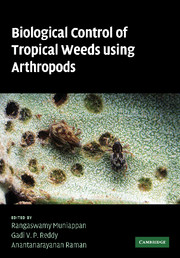Book contents
- Frontmatter
- Contents
- List of contributors
- Acknowledgments
- 1 Biological control of weeds in the tropics and sustainability
- 2 Acacia nilotica ssp. indica (L.) Willd. ex Del. (Mimosaceae)
- 3 Australian Acacia species (Mimosaceae) in South Africa
- 4 Ageratina adenophora (Sprengel) King and Robinson (Asteraceae)
- 5 Azolla filiculoides Lamarck (Azollaceae)
- 6 Cabomba caroliniana Gray (Cabombaceae)
- 7 Invasive cactus species (Cactaceae)
- 8 Chromolaena odorata (L.) King and Robinson (Asteraceae)
- 9 Clidemia hirta (L.) D. Don (Melastomataceae)
- 10 Coccinia grandis (L.) Voigt (Cucurbitaceae)
- 11 Eichhornia crassipes (Mart.) Solms–Laub. (Pontederiaceae)
- 12 Lantana camara Linn. (Verbenaceae)
- 13 Mimosa diplotricha C. Wright ex Sauvalle (Mimosaceae)
- 14 Mimosa pigra L. (Leguminosae)
- 15 Parthenium hysterophorus L. (Asteraceae)
- 16 Passiflora mollissima (HBK) Bailey (Passifloraceae)
- 17 Pistia stratiotes L. (Araceae)
- 18 Prosopis species (Leguminosae)
- 19 Salvinia molesta D. S. Mitchell (Salviniaceae)
- 20 Solanum mauritianum Scopoli (Solanaceae)
- 21 Application of natural antagonists including arthropods to resist weedy Striga (Oranbanchaceae) in tropical agroecosystems
- 22 Biological control of weeds in India
- 23 The role of International Institute of Tropical Agriculture in biological control of weeds
- 24 The role of Secretariat of the Pacific Community in the biological control of weeds in the Pacific Islands region – past, present, and future activities
- Index
5 - Azolla filiculoides Lamarck (Azollaceae)
Published online by Cambridge University Press: 04 August 2010
- Frontmatter
- Contents
- List of contributors
- Acknowledgments
- 1 Biological control of weeds in the tropics and sustainability
- 2 Acacia nilotica ssp. indica (L.) Willd. ex Del. (Mimosaceae)
- 3 Australian Acacia species (Mimosaceae) in South Africa
- 4 Ageratina adenophora (Sprengel) King and Robinson (Asteraceae)
- 5 Azolla filiculoides Lamarck (Azollaceae)
- 6 Cabomba caroliniana Gray (Cabombaceae)
- 7 Invasive cactus species (Cactaceae)
- 8 Chromolaena odorata (L.) King and Robinson (Asteraceae)
- 9 Clidemia hirta (L.) D. Don (Melastomataceae)
- 10 Coccinia grandis (L.) Voigt (Cucurbitaceae)
- 11 Eichhornia crassipes (Mart.) Solms–Laub. (Pontederiaceae)
- 12 Lantana camara Linn. (Verbenaceae)
- 13 Mimosa diplotricha C. Wright ex Sauvalle (Mimosaceae)
- 14 Mimosa pigra L. (Leguminosae)
- 15 Parthenium hysterophorus L. (Asteraceae)
- 16 Passiflora mollissima (HBK) Bailey (Passifloraceae)
- 17 Pistia stratiotes L. (Araceae)
- 18 Prosopis species (Leguminosae)
- 19 Salvinia molesta D. S. Mitchell (Salviniaceae)
- 20 Solanum mauritianum Scopoli (Solanaceae)
- 21 Application of natural antagonists including arthropods to resist weedy Striga (Oranbanchaceae) in tropical agroecosystems
- 22 Biological control of weeds in India
- 23 The role of International Institute of Tropical Agriculture in biological control of weeds
- 24 The role of Secretariat of the Pacific Community in the biological control of weeds in the Pacific Islands region – past, present, and future activities
- Index
Summary
Introduction
Azolla Lam. is an aquatic fern taxon, which grows in symbiotic association with Anabaena azolla Strasburger (Nostocales: Nostocaceae) within the dorsal leaf lobe cavities (Ashton and Walmsley, 1976, 1984). Anabaena azolla can fix atmospheric nitrogen and is able to fulfill nitrogen requirements of Azolla, making it able to thrive in nitrogen-deficient waters (Ashton, 1974, 1978). Azolla is economically important and has been used in Southeast Asia as a green manure associated with wetland rice cultivation for the last 200 years (Lumpkin and Plucknett, 1982). However, the wider utilization of Azolla for agricultural purposes has been constrained by various biological factors including low tolerance to high temperatures and insect damage (Van Cat et al., 1989) and application of ammonia-based fertilizers (Lumpkin and Plucknett, 1982).
Taxonomy
Early classifications of Azolla were based mainly on vegetative characteristics, in particular, using the form and size of leaves (Svenson, 1944). This, however, has led to considerable confusion, since the phenotypes of Azolla are plastic, varying under environmental influences (Ashton, 1978; Wantanabe and Berja, 1983; Moretti and Gigliano, 1988). Zimmermann et al. (1989) reclassified Azolla using electrophoretic techniques, whereas Nayak and Singh (1989) used cytological techniques. Traditionally 25 fossil and seven extant species of Azolla are recognized (Hills and Gopal, 1967; Lumpkin and Plucknett 1980; Ashton and Walmsley, 1984), which are divided into two sections:
As to the status of A. pinnata, some confusion prevails. Initially it was regarded as a complex of A. pinnata, A. africana Desv. and A. imbricata Roxb. ex Griff., but later reduced to one species with two varieties, A. pinnata var. imbricata and A. pinnata var. africana (also called var. pinnata) (Sweet and Hills, 1971; Stergianaou and Fowler, 1990).
- Type
- Chapter
- Information
- Biological Control of Tropical Weeds Using Arthropods , pp. 74 - 87Publisher: Cambridge University PressPrint publication year: 2009
- 7
- Cited by



